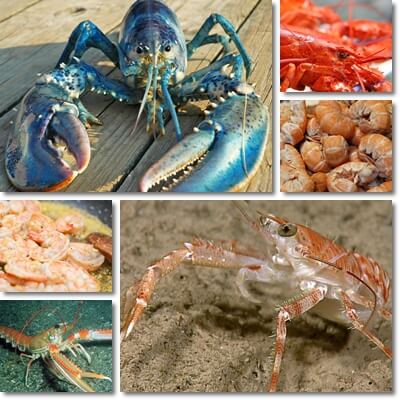Langoustine is a small species of lobster identified by the scientific name Nephrops norvegicus. Versus langostino which is the common name for the following three species of squat lobster: Pleuroncodes monodon, Cervimunida johni and Munida gregaria. Versus ‘lobster’ which is a common name used to refer to the two most important commercial species of lobster: the American or the Maine lobster (Homarus americanus) and the European or the common lobster (Homarus gammarus).
Langoustine is also frequently referred to as langoustine lobster, a pairing of common names meant to identify it as a species of lobster, which it is. The purpose is to give the species greater economic importance or marketing value since lobsters are known as a delicacy and for being expensive. Langostino is also sometimes called langostino lobster, for the same reason langoustine is. But when people say ‘lobster’, they strictly refer to either the American/Maine or the European/common lobster.

While the names may seem confusing if you are not well-acquainted with all of these crustaceans, they are actually useful in the sense that they help you know what you are actually eating (that is, when used correctly). Both langoustine and langostino are small species of lobster, but not the lobsters most people are thinking of when they say ‘lobster’. In everyday normal language, this particular word, when used plainly, refers to the American and European lobsters, which are not langoustines or langostinos.
Difference by common names
The difference between langoustine, langostino and lobster by common names:
1) Langoustine, langoustine lobster, Norway lobster, Dublin bay prawn, scampi
Versus
2) Langostino, langostino lobster, Chilean langostino, red langostino (Pleuroncodes monodon), yellow langostino (Cervimunida johni), red or yellow squat lobster, galatheid crab
Versus
3) Lobster, true or red lobster, American, Canadian or Maine lobster (Homarus americanus), European or common lobster (Homarus gammarus)
Difference by appearance
How else can you tell the difference between langoustine, langostino and lobster? Except for names, really, the easiest way to tell these crustaceans apart is by appearance. While they look similar in certain respects, they are also fairly dissimilar and noticing the little and not so little differences can help you tell which is which.

Langoustine vs langostino. Langoustine looks more like a large species of shrimp or prawn. It’s narrow, appearing long and slender, with a segmented body ending in a fan-shaped tail. It has slender-looking claws on the front pair of legs and beady, kidney-shaped eyes. Langoustine shell color is light orange or orange-pink, but the crustacean is white underneath. It weighs up to 250 g with a maximum body length of 25 cm.
By comparison, langostino looks more like a crab than a shrimp, hence the common name ‘galatheid crab’ (derived from the name of the family some of the most commercially popular species belong to, Galatheidae, and the crab-like appearance of the crustaceans). Its body is more rounded in shape and flattened at the same time. While it has claws on its front legs, the claws are bulkier looking than those of a langoustine. It’s also segmented, with a fan-shaped tail, but keeps it hidden underneath its chest cavity, looking as if it’s somehow squatting (likely the origin of the name squat lobster). Shell color is typically either a bright red color or orange-red (other squat lobster species that are not langostino have multiple colors and patterns on their shell, including blues, purples, stripes and spots).
Langoustine vs lobster. The main difference between lobster and langoustine is the size: lobsters (as in the two most popular commercial species, the American species Homarus americanus and the European species Homarus gammarus) are giants, weighing up to 20 kilograms and 6 kilograms respectively; langoustines weigh up to 250 grams. Lobsters have thick, hard, rounded shells, slightly triangular towards the head (a part called rostrum) with bulky claws on their front legs. Langoustines have a long and slender body, looking more like a large shrimp or prawn, and similarly slender-looking claws on their front legs.
In the European lobster, shell color is mostly blue (usually darker) with yellow and purple tinges and creamy white towards the tips of the claws and underneath the crustacean. In the American lobster, the shell is a mix of orange-red and dark brown with yellow tinges, whilst the legs are tinged green. It only turns bright red after cooking. Whereas the langoustine is naturally orange pink on top and white underneath and stays the same color after cooking.
Lobster vs langostino. The three commercial langostino species, Pleuroncodes monodon, Cervimunida johni and Munida gregaria, look more like crabs to the untrained eye. Langostinos are a lot smaller, with a body length of only 8-15 cm and weighing up to 200 g on average. Whereas lobsters (the European and American variety) can grow to 60 cm or more in length (claws not included in the measurements) and weigh up to 6 and 20 kilograms respectively.
Shell color is different too. Langostinos are naturally bright-red or orange-red and stay the same color after cooking. Whereas lobsters are naturally dark blue with a little yellow, purple and creamy white (the European variety) or a mix of orange-red with dark brown and legs tinged green (the American variety). They only turn bright red after cooking. The body is the same shape in both species, rounded and slightly triangular towards the head (a body part called the rostrum), but the langostino is also a little flattened. Both species have a segmented body ending in a fan-shaped tail, but in the langostino, the tail is kept underneath the chest cavity, a characteristic of squat lobsters.
